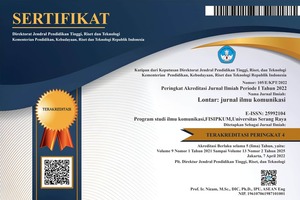FENOMENA BERITA KEKERASAN di MEDIA TELEVISI (Perspektif Teori Kultivasi) NEWS MEDIA PHENOMENON OF VIOLENCE IN TELEVISION (Cultivation Theory Perspective)
DOI:
https://doi.org/10.30656/lontar.v4i2.330Abstract
This study focuses on the influence of the intensity of the frequency of the audience watching the news that contain violence. The number of television stations that broadcast news of the violence repeatedly affect children's behavior in everyday life. Booming charge news this violence resulted in all the mainstream media are vying for presenting the news of violence and neglect the effects of what is broadcast. News show as a phenomenon and a momentum to reach the audience as much as possible for television stations. Construction purposes in many television news reality changing audience behavior, since television emerged as a second mother who where viewers can learn a lot through television broadcasts. Cultivation perspective analysis is an analysis that starts from the messaging system to identify patterns of permanent, continuous, overaching of content in television. The division of light viewer, media viewer, and the viewer heavy intensity measured from the time of respondents watching television, the most important thing there is a frequency difference between the intensity of the respondents watch. By using a cultivation perspective on this assessment reveal the intensity of the frequency of watching news of violence can effect/specific impact for the audience.Downloads
Published
Issue
Section
License
By submitting an article to the journal, the author(s) agree to transfer the published article's copyright to the journal, which will act as the publisher. This means the journal will have the right to publish the article in various forms, including reprints. The journal will maintain the publishing rights to the published articles.
In line with the license, authors and third parties (readers, researchers, and others) are allowed to share and adapt the material. In addition, the material must be given appropriate credit, provided with a link to the license, and indicated if changes were made. If authors remix, transform, or build upon the material, authors must distribute their contributions under the same license as the original.






